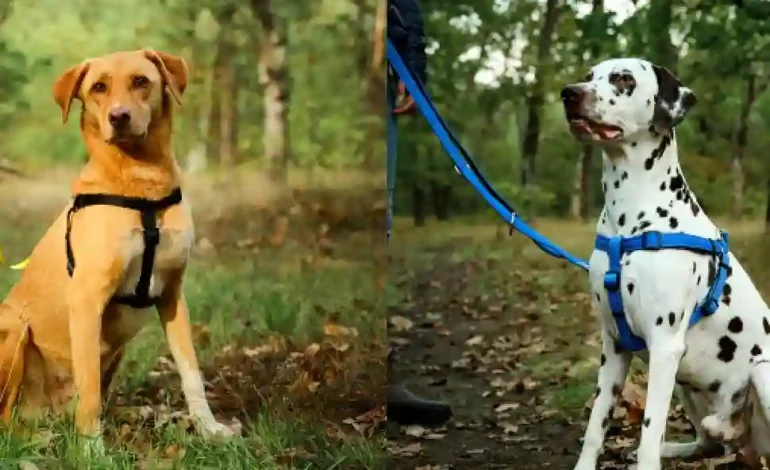
Balancing Act: The Use of Weight-Pulling Harnesses in Canine Fitness
Canine fitness and exercise are crucial for a dog’s physical and mental well-being. While activities like walking, running, and playing are essential, some dogs thrive on more challenging workouts. Weight-pulling harnesses have gained popularity as a means to provide dogs with intense physical exercise and mental stimulation. In this article, we will explore the use of weight-pulling harnesses in canine fitness, their benefits, safety considerations, and how to get started with this engaging activity.
The Basics of Weight-Pulling for Dogs
Weight-pulling for dogs is a canine sport where dogs pull a weighted sled, cart, or object over a specified distance. This activity capitalizes on a dog’s natural strength and desire to work. It’s not only an excellent way to provide physical exercise but also mental stimulation and a sense of accomplishment.
Benefits of Weight-Pulling for Dogs
Weight-pulling harnesses offer several advantages for dogs:
- Physical Exercise: Weight-pulling provides a full-body workout, helping to build muscle, improve endurance, and maintain a healthy weight.
- Mental Stimulation: Dogs engaged in weight-pulling must use problem-solving skills to understand commands and negotiate obstacles, providing mental stimulation.
- Bonding: Weight-pulling fosters a strong bond between the dog and its handler, as it requires trust and cooperation.
- Confidence Building: Dogs that participate in weight-pulling often gain confidence, as they learn to tackle challenges and achieve goals.
- Fun and Engagement: Many dogs enjoy the activity, making it a fun and engaging way to spend time together.
Safety Considerations
While weight-pulling can be a rewarding activity, safety is paramount. Here are essential safety considerations:
- Health Check: Ensure your dog is physically fit for weight-pulling. Consult with your veterinarian to rule out any underlying health issues.
- Proper Equipment: Invest in a high-quality weight-pulling harness designed specifically for dogs. These harnesses distribute weight evenly and prevent injury.
- Gradual Progression: Start with light weights and gradually increase the load over time. Overloading your dog too soon can lead to injuries.
- Training: Proper training is essential. Teach your dog commands like “pull” and “stop,” and ensure they understand and respond to these cues.
- Warm-Up and Cool Down: Always begin with a warm-up and end with a cool-down to prevent muscle strain.
- Surface and Terrain: Choose safe and appropriate surfaces and terrain for weight-pulling to reduce the risk of injury.
- Hydration and Rest: Provide plenty of water breaks, and watch for signs of exhaustion or overexertion. Dogs should rest between pulls.
Getting Started with Weight-Pulling
Here’s how to begin weight-pulling training with your dog:
- Choose the Right Harness: Invest in a well-fitting weight-pulling harness designed for your dog’s size and breed. Consult with a professional if needed.
- Consult with a Trainer: Consider working with a professional dog trainer experienced in weight-pulling. They can help you get started and ensure you’re using proper techniques.
- Select Appropriate Equipment: Begin with a lightweight sled or cart, and gradually increase the weight as your dog gets accustomed to the activity.
- Basic Commands: Teach your dog basic commands like “pull,” “stop,” and “wait.” Ensure they understand and respond to these commands consistently.
- Start Slowly: Begin with short, light training sessions, gradually increasing the duration and intensity.
- Use Positive Reinforcement: Reward your dog with treats and praise for successfully pulling weights. Positive reinforcement encourages them to enjoy the activity.
- Safety First: Always prioritize safety. Ensure your dog is wearing the harness correctly, and regularly check for any signs of discomfort or rubbing.
- Monitor Progress: Keep track of your dog’s progress, both in terms of strength and endurance. Adjust the weight and training regimen accordingly.
- Hydration and Rest: Provide plenty of water breaks during training, and allow your dog to rest between pulls.
- Vary the Terrain: Mix up the terrain and location of your weight-pulling sessions to keep your dog engaged and adapt to different challenges.
Common Weight-Pulling Competitions
Weight-pulling competitions are popular in the canine sports world, providing a platform for dogs to showcase their strength and skills. Some common weight-pulling events include:
- Sled Dog Pull: Dogs pull a weighted sled across a set distance, simulating the work of sled dogs.
- Cart Pull: Similar to sled pulls, dogs pull a cart loaded with weights.
- Urban Mushing: Dogs pull a weighted cart or scooter through urban environments, navigating streets and sidewalks.
- Backpacking: Dogs carry weighted backpacks on hikes, promoting endurance and strength.
Conclusion
Weight-pulling is an engaging and physically rewarding activity for dogs, offering numerous benefits in terms of fitness, mental stimulation, and bonding with their handlers. However, it’s essential to prioritize safety and proper training when introducing your dog to weight-pulling. Start slowly, use appropriate equipment, and consult with professionals if needed. With the right approach, weight-pulling can be a fulfilling and enjoyable activity for both you and your canine companion, promoting a healthy and active lifestyle.





